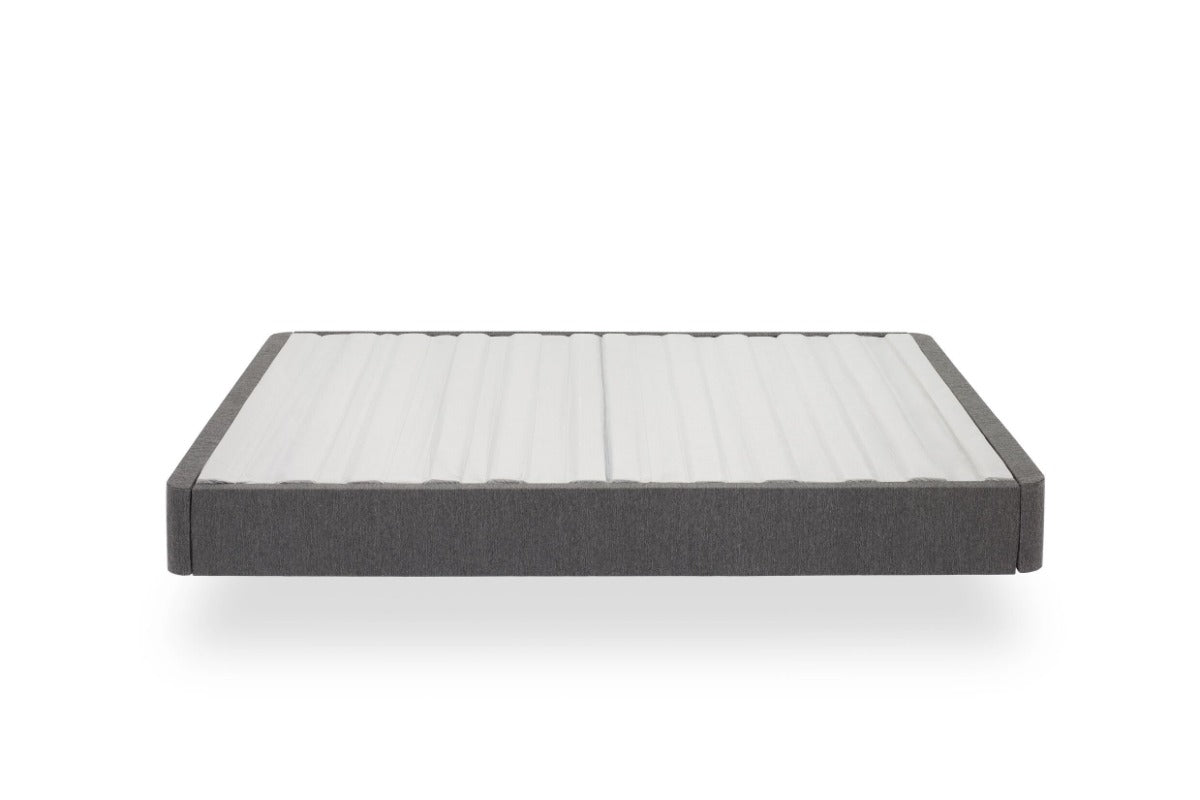The longevity and comfort of your mattress rely heavily on the quality of your mattress’s foundation. If you're wondering how long box springs last or how long a mattress lasts, it's clear you care about protecting both your sleep quality and your mattress investment.
A standard box spring can last up to ten years, depending on its quality. Let's explore the different types of mattress foundations, how to maintain your current box spring, and how to know when it’s time to upgrade.
The Different Types of Mattress Foundations
A high-quality box spring or foundation could last up to 10 years, while a low-quality option might wear out in less than five years. Prioritizing craftsmanship is essential when selecting a mattress foundation.
While "box spring" is sometimes used as a catch-all term for mattress foundations, there are several distinct types:
- The Box Spring: This classic foundation is a wood or metal box filled with metal springs to cushion and support the mattress. Box springs work well with older innerspring mattresses but are less compatible with newer memory foam mattresses, adjustable beds, or platform beds.
- The Mattress Foundation: A durable alternative to box springs, mattress foundations use a slat system to support the mattress. A chic fabric layer covers the foundation, adding style. Proper mattress foundations—like those offered by Casper—can support various mattress types and enhance the sleeping experience.
- The Platform Bed: Platform beds have built-in foundations made of wood, metal, or plastic. They are compatible with almost all mattress types and often come in fashionable styles. These options require no additional accessories, making them a low-maintenance mattress foundation.
Airflow: The Key Ingredient to a Good Night’s Sleep
When most people talk about box springs, they focus on support and longevity—both big deals, of course. But there’s another essential factor at play: airflow.
A well-ventilated foundation can help keep moisture and heat from getting trapped in your mattress. By allowing air to circulate, you’ll reduce the risk of unwanted odors, dust mites, and other bedroom bummers. Whether you opt for a classic box spring or a mattress foundation, prioritizing airflow helps your mattress stay fresher, drier, and more comfortable night after night. Think of it as a gentle breeze under your bed, providing comfort and extending the mattress lifespan.
Beyond the Basics: Bunkie Boards, Adjustable Bases, and More
Box springs, foundations, and platform beds aren’t your only options. Consider different preferences and find what suits your lifestyle best. If you’re looking for something a little different, you can explore:
- Bunkie Boards – These ultra-thin boards can be placed directly on a bed frame to enhance mattress support—perfect for anyone looking to minimize bulk.
- Adjustable Bases – Control your sleep angle with just the push of a button for maximum support. An adjustable bed frame lets you elevate your head or feet for personalized comfort.
- Euroslats – These feature slats that flex under pressure, offering an extra bit of contour and support. That means less pressure on your shoulders and hips, which prevents wear on your mattress and offers a cozier feel overall.
If you like to keep your sleep setup simple, don’t fret—your box spring or foundation can still deliver all the nightly comfort you need. But if your lifestyle or preferences call for more customization, these alternatives can be just the ticket to better rest.
Factors That Impact Your Box Spring’s Longevity
Understanding the factors that affect your box spring’s lifespan can help you maintain it effectively and determine when it’s time for an upgrade. Good hygiene and proper maintenance are key.
1. Good Hygiene
Eating in bed can attract pests that may damage your box spring and mattress. Keep snacks in the kitchen and wash your sheets at least once a week to prevent bacteria buildup. Investing in a mattress protector can also prevent sweat from creating a breeding ground for bacteria.
To prevent dust mites and bed bugs from inhabiting your box spring, clean it every three months. Vacuuming is a good start. For a thorough cleaning, place your mattress and box spring outside in the sun, as sunlight naturally disinfects and removes moisture.
2. Proper Maintenance
Just as you should rotate your mattress every three to six months, you should also rotate your box spring 180 degrees to ensure even wear.
Avoid jumping on the bed, as the box spring absorbs shock and excessive force can cause it to deteriorate more quickly. Additionally, plan to replace your mattress and box spring together to extend their lifespans.
Signs You Need a New Box Spring
If you're unsure whether it's time to replace your box spring, look for these indicators:
- Persistent Sagging: Sagging can indicate that your box spring and mattress are nearing the end of their lifespans.
- Old Springs: If your box spring contains steel coil springs over 10 years old, consider purchasing a new, more durable foundation.
- Damaged Steel Grid: Check for a bent or broken steel grid within your box spring.
- Constant Squeaking: Squeaking noises suggest that the internal joints are loose or weak.
If you observe these signs, it may be time to upgrade your sleep experience.
A Solid Night’s Sleep with Casper
When your box spring wears out, it can significantly impact your daily life. At Casper, we understand that sleep wellness influences overall well-being. That's why we dedicate our efforts to providing quality rest for all types of sleepers.
Whether you're a side sleeper, stomach sleeper, or back sleeper, a solid snooze starts with a comfortable mattress. From there, your sleep journey is supported by a proper mattress foundation.
If it’s time to say goodbye to your old box spring or mattress, we welcome you to experience healthy, hearty sleep with Casper.
Sources:
- The Huffington Post. So Just How Bad Is It To Eat In Your Bed? https://www.huffpost.com/entry/eating-in-bed-truth_n_5864458
- Healthline. How Often Should You Change Your Sheets? https://www.healthline.com/health/how-often-should-you-change-your-sheets
- Business Insider. A microbiologist explains why he hasn’t slept without this on his bed in 25 years. https://www.businessinsider.com/how-often-to-replace-mattress-2017-9
- HowStuffWorks. Can You Disinfect Your Mattress? https://home.howstuffworks.com/home-improvement/household-hints-tips/cleaning-organizing/can-you-disinfect-your-mattress.htm
- Sleep Advisor. Do I Need a Box Spring for My Mattress? https://www.sleepadvisor.org/do-you-need-a-box-spring/
- Hunker. When To Replace A Box Spring. https://www.hunker.com/12200766/why-replace-box-springs
- Slumber Yard. What Is A Mattress Foundation? (Explained). https://myslumberyard.com/blog/what-is-a-mattress-foundation/
- Hunker. How to Clean a Box Spring. https://www.hunker.com/13420771/how-to-clean-a-box-spring
- Savvy Sleeper. How Often Should You Flip or Rotate Your Mattress? https://savvysleeper.org/how-often-should-you-flip-or-rotate-your-mattress/











